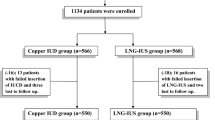Abstract
The Stainless Steel Ring, Uterine Cavity-Shaped Device, TCu220C and MLCu375 IUDs were evaluated in a randomized trial of 1536 women in Guangdong Province, China. The first-year continuation and expulsion rates were significantly lower (p<0.05) for the latter 3 IUDs than for the Stainless Steel Ring. The first year pregnancy rates for the MLCu375 (o.76 per 100 women) and TCu220C (1.2 per 100 women) were significantly lower (p<0.05) than those of the other two devices (6.1 and 4.1 per 100 women). The results of the study show that the MLCu375 and TCu220 are the most suitable IUDs for women in Guangdong Province.
Resumé
Une étude randomisée portant sur 1536 femmes a été effectuée dans la province de Guangdong (China) pour évaluer l'anneau contraceptif en acier inoxydable, un dispositif épousant la forme de la cavité utérine, ainsi que les dispositifs TCu220C et MLCu375. Les pourcentages de continuation pour la première année et les taux d'expulsion ont été significativement moins élevés (p<0,05) pour les 3 derniers que ceux pour l'anneau en acier inoxydable. Les taux de grossesse pendant la première année dans le cas du MLCu375 (0,76 par 100 femmes) et du TCu220C (1,2 par 100 femmes) ont été significativement plus faibles (p<0,05) que pour les deux autres dispositifs (6,1 et 4,1 par 100 femmes). Les résultats de cette étude montrent que les DIU MLCu375 et TCu220C sont les dispositifs qui conviennent le mieux aux femmes de la province de Guangdong.
Resumen
Se realizó un estudio aleatorizado de 1536 mujeres de la provincia de Guangdong, China, a fin de evaluar el anillo anticonceptivo de acero inoxidable, un dispositivo que tiene la forma de la cavidad uterina y los dispositivos intrauterinos TCu220C y MLCu375. Los porcentajes de continuación relativos al primer año y los porcentajes de expulsión fueron significativamente inferiores (p<0,05) para los tres últimos que para el anillo de acero inoxidable. Los porcentajes de embarazo durante el primer año en el caso del MLCu375 (0,76 por cada 100 mujeres) y TCu220C (1,2 por cada 100 mujeres) fueron significativamente inferiores (p<0,05) que para los dos otros dispositivos (6,1 y 4,1 por cada 100 mujeres). Los resultados de este estudio demuestran que los DIU MLCu375 y TCu220C son los más adecuados para las mujeres de la provincia de Guangdong.
Similar content being viewed by others
References
Treiman K, Liskin L. IUDs — a new look. Population Reports, Series B, No 5:1988.
Hui-MinF, XiaoH, Ming-HyuW. Clinical comparison of four types of IUDs made in China. Reprod Contracept. 1983;3:12–7.
ShihS, Li-JuanQ, ZuanL. Comparative clinical experience with 3 IUDs, TCu380Ag, TCu220C and Mahua Ring in Tianjin, People's Republic of China. Contraception. 1984;29:229–39.
Dixon WJ, Brown MB, Engleman L, Hill MA, Jennrich RI. BMDP statistical software manual. University of California Press; 1989.
World Health Organization. Mechanism of action, safety, and efficacy of intrauterine devices. Technical Report Series 753, World Health Organization; 1987.
AllonenH, LuukkainenT, NielsenNC, NygrenKG, PyoralaT. Factors affecting the clinical performance of Nova T and Copper TCu220. Obstet Gynecol. 1984;64:524–29.
ChiI-C, FarrG, DominikR, RobinsonN. Do retroverted uteri adversely affect insertions and performance of IUDs? Contraception. 1990;41:495–506.
TietzeC. Evaluation of intrauterine devices: ninth progress report of the Cooperative Statistical Program. Stud Fam Plann. 1970;45:1–40.
LassionB, HagstromB, VibergL, HambergerL. Long-term clinical experience with the Cu-7 IUD. Contraception. 1987;23:387–97.
QianLJ, LiJZ, SungLJ, WangMY, GuaMW. A randomized comparative study of the performance of seven different sizes of the Mahua ring inserted following measurement of the uterine cavity and one size of the same ring. Contraception. 1990;42:391–402.
Author information
Authors and Affiliations
Rights and permissions
About this article
Cite this article
Ho, J., Wu, Z., Cal, S. et al. A randomized comparative trial of the MLCu375, TCu220C, Steel Ring and Uterine Cavity-Shaped IUDs. Adv Contracept 8, 161–166 (1992). https://doi.org/10.1007/BF01849754
Received:
Accepted:
Issue Date:
DOI: https://doi.org/10.1007/BF01849754




